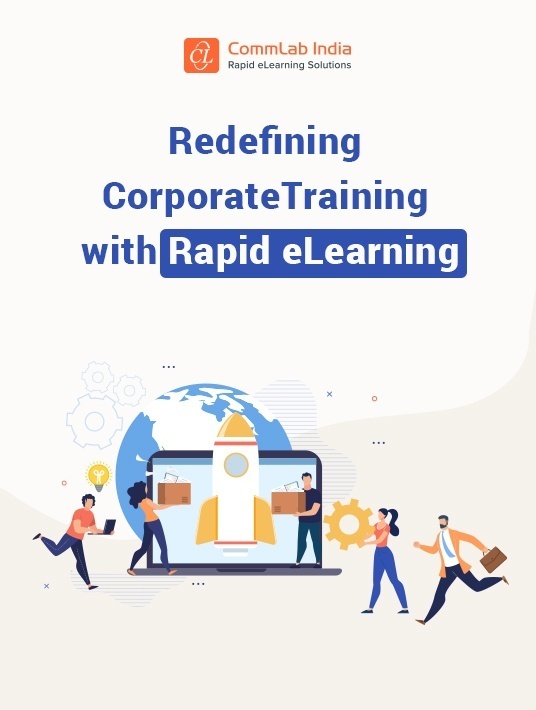Rapid eLearning For Gamification
"All work and no play makes Jack a dull boy." This quote rings true not just for Jack but for corporate training as well! It constantly reminds us, L&D professionals, about the importance of designing interesting and engaging training programs. When learners have fun while learning, it doesn’t seem burdensome, and the knowledge stays with them for a longer time.

This is why "edutainment" is becoming the new norm today, and what better way to achieve this than games? Gamification and game-based learning have changed the rules of learner engagement for the better, and rapid eLearning deserves the credit for making it possible [1].
The Role Of Edutainment In eLearning
Edutainment is more than a blend of education and entertainment [2]. It represents the paradigm shift in L&D as we transition from an information age to a conceptual age. It’s no longer enough to just provide information to learners—and maybe create a cognitive overload. Instead, it is becoming imperative to make training more engaging and experiential with increased retention for improved performance on the job. You can edutain learners in eLearning through AR/VR simulations and Instructional Design strategies such as LEAD, game-based learning, and gamification [3].
Game-Based Learning Vs. Gamification
In eLearning courses, game mechanics can be used in two ways: game-based design and gamification.
- Game-based eLearning courses integrate game elements into the content and the entire course is designed and operates like a game.
- Gamification is the application of game mechanics such as points, rewards, and scores in a non-game context such as training.
With gamification, game elements are only used as rewards (points, badges, leaderboard scores, etc.) or incentives (timer, extra lives) to promote interest in learning and drive learning outcomes.
Developing an engaging course with gamification requires robust Instructional Design abilities and authoring tool expertise. Game-based eLearning courses are expensive and take a lot of time to develop. But gamification as a strategy can be deployed easily by employing rapid eLearning and leveraging authoring tools. Here is how you can go about it.
Leveraging Instructional Design Expertise
When it comes to gamification, Instructional Designers play a major role and are responsible for designing the strategy. Instructional Designers need to come up with ways to fit gamification elements such as points [4], levels, progress, roadmaps, leaderboards, and avatars to fit the training content. Here are a few ways on how Instructional Designers can achieve it.
- The first involves chunking the content into different modules that serve as levels within the course.
- Then, points or badges are assigned for each level. These levels are usually arranged in increasing order of difficulty.
- Reward points and/or badges are unlocked every time a learner successfully finishes a module.
- A leaderboard can be used to highlight the cumulative rewards earned and also the progress of the learner.
Gamification can also be used to provide an element of personalization in eLearning courses using avatars [5]. Avatars may be present throughout the course to guide the learner or appear only in the introductory, transition, and assessment slides to highlight the learning objectives, feedback, and summary.
Gamification can be used as a roadmap for eLearning assessments [6]—both formative and summative. Passing each formative assessment—which can be timed or unlock the next level—allows the learner to move ahead in the course. Successfully passing summative assessments will allow the learner to move on to the next course or unlock an achievement/badge.
Using Rapid Authoring Tools
Many authoring tools such as Articulate Storyline, iSpring, and Adobe Captivate provide templates and layouts which can be customized easily to develop gamified courses. In case the pre-built templates do not fit your requirements, you can always create customized layouts using stock images and graphics.
In-built triggers and interactivities will allow the rapid development of customized gamified templates. These layouts can be saved and reused in other courses as well. Here are gamified templates developed in Articulate Storyline [7].
Designing A Mobile Gaming Experience
If there is one thing learning solutions can’t do without today, it’s mobile learning. You can’t take advantage of the scope and benefits offered by gamification without making courses accessible on mobile devices. Together, gamification and mobile learning provide a high degree of motivation to learners [8], giving them control of their own learning as well as providing them with a continuous learning experience with no cause for pause.
Designing a gamified, mobile-responsive course doesn’t entail additional cost or time. Most mobile-responsive authoring tools can be used to develop gamified courses. A gamified mobile learning course can be effectively used for:
- Just-In-Time learning
- Performance support
- Refresher training
There is nothing a training manager would want more than finding a training strategy that will improve learner engagement and prove to be value for money. Hope this article about edutainment and gamification has piqued your interest enough to try them in your training plan. Leverage the power of rapid eLearning and design fun-filled, cost-effective, and reusable gamified courses that will make your learners ask for more. Download the eBook Redefining Corporate Training With Rapid eLearning and join the webinar to get the chance to incorporate modern learning strategies into your training quickly and easily.
References:
[1] Rapid eLearning: The Secret to Evolving @ Speed of Business
[2] Edutainment: Making eLearning Fun for Millennials
[3] Instructional Design Strategies – Magic Potions to Engaging eLearning [Infographic]
[5] Using Characters in eLearning to Bring it to Life: What, Why, and How
[6] 3 Reasons to Use Confidence-based Assessments in eLearning
[7] 10 Free eLearning Games Templates
[8] Microlearning and Mobile learning – The Powerful Duo [Infographic]









